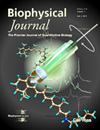Tool抗体片段揭示了视紫红质- gi信号复合物的多种构象。
IF 3.1
3区 生物学
Q2 BIOPHYSICS
引用次数: 0
摘要
抗体Fab片段是广泛使用的蛋白质结合物,有助于G蛋白偶联受体(GPCR)信号复合物的结构研究。将这些结合物的范围扩大到针对信号复合物的不同组分,为探索构象调节和动力学提供了机会。在这里,我们报道了两个Fab片段Fab79和Fab13的生化和低温电镜表征,这些片段是针对视紫红质- g αiβγ复合物提出的。Fab79结合到Gαi亚基的柔性α-螺旋结构域(AHD)上,并在GTP类似物GTPγ s不可水解的情况下阻止复合物解离,可能是通过阻碍AHD闭合,这是复合物解离的必要步骤。相比之下,Fab13与Gβ紧密结合,而不直接接触Gα或受体。这些发现表明Fab79和Fab13揭示了G蛋白激活的功能相关构象状态,并可作为稳定或调节GPCR信号复合物的实用工具。本文章由计算机程序翻译,如有差异,请以英文原文为准。
Tool antibody fragments reveal multiple conformations of the rhodopsin-Gi signaling complex.
Antibody Fab fragments are widely used protein binders that assist in structural studies of G protein-coupled receptor (GPCR) signaling complexes. Expanding the repertoire of such binders to target distinct components of the signaling complex offers opportunities to probe conformational regulation and dynamics. Here, we report the biochemical and cryo-EM characterization of two Fab fragments, Fab79 and Fab13, raised against the rhodopsin-Gαiβγ complex. Fab79 binds to the flexible α-helical domain (AHD) of the Gαi subunit and prevents complex dissociation in the presence of the non-hydrolyzable GTP analog, GTPγS, likely by hindering AHD closure, a step necessary for complex dissociation. In contrast, Fab13 binds rigidly to Gβ without directly contacting Gα or the receptor. These findings show that Fab79 and Fab13 reveal functionally relevant conformational states of G protein activation and serve as practical tools to stabilize or modulate GPCR signaling complexes.
求助全文
通过发布文献求助,成功后即可免费获取论文全文。
去求助
来源期刊

Biophysical journal
生物-生物物理
CiteScore
6.10
自引率
5.90%
发文量
3090
审稿时长
2 months
期刊介绍:
BJ publishes original articles, letters, and perspectives on important problems in modern biophysics. The papers should be written so as to be of interest to a broad community of biophysicists. BJ welcomes experimental studies that employ quantitative physical approaches for the study of biological systems, including or spanning scales from molecule to whole organism. Experimental studies of a purely descriptive or phenomenological nature, with no theoretical or mechanistic underpinning, are not appropriate for publication in BJ. Theoretical studies should offer new insights into the understanding ofexperimental results or suggest new experimentally testable hypotheses. Articles reporting significant methodological or technological advances, which have potential to open new areas of biophysical investigation, are also suitable for publication in BJ. Papers describing improvements in accuracy or speed of existing methods or extra detail within methods described previously are not suitable for BJ.
 求助内容:
求助内容: 应助结果提醒方式:
应助结果提醒方式:


